Safeguarding Intervention Report: Care Act 2014 and Clarrie
VerifiedAdded on 2023/01/13
|11
|3421
|72
Report
AI Summary
This report delves into safeguarding interventions, focusing on the protection of adults and the prevention of harm, abuse, and neglect. It explores two key interventions: making safeguarding personal and positive risk-taking, and applies them to a case study involving a patient named Clarrie who struggles with an eating disorder and hoarding. The report justifies the use of these interventions by referencing relevant legislation, such as the Care Act 2014, and emphasizing the importance of a user-led approach. It examines the benefits and potential problems faced by professionals, including criticisms of the interventions. The report highlights the importance of considering the individual's needs and preferences, ensuring their empowerment and promoting their well-being. It also discusses the role of professionals in providing emotional support and helping individuals make informed decisions, while adhering to safeguarding principles such as empowerment, prevention, proportionality, protection, partnership, and accountability. The report emphasizes the need for transparency and the consideration of the individual's rights and values throughout the care process.
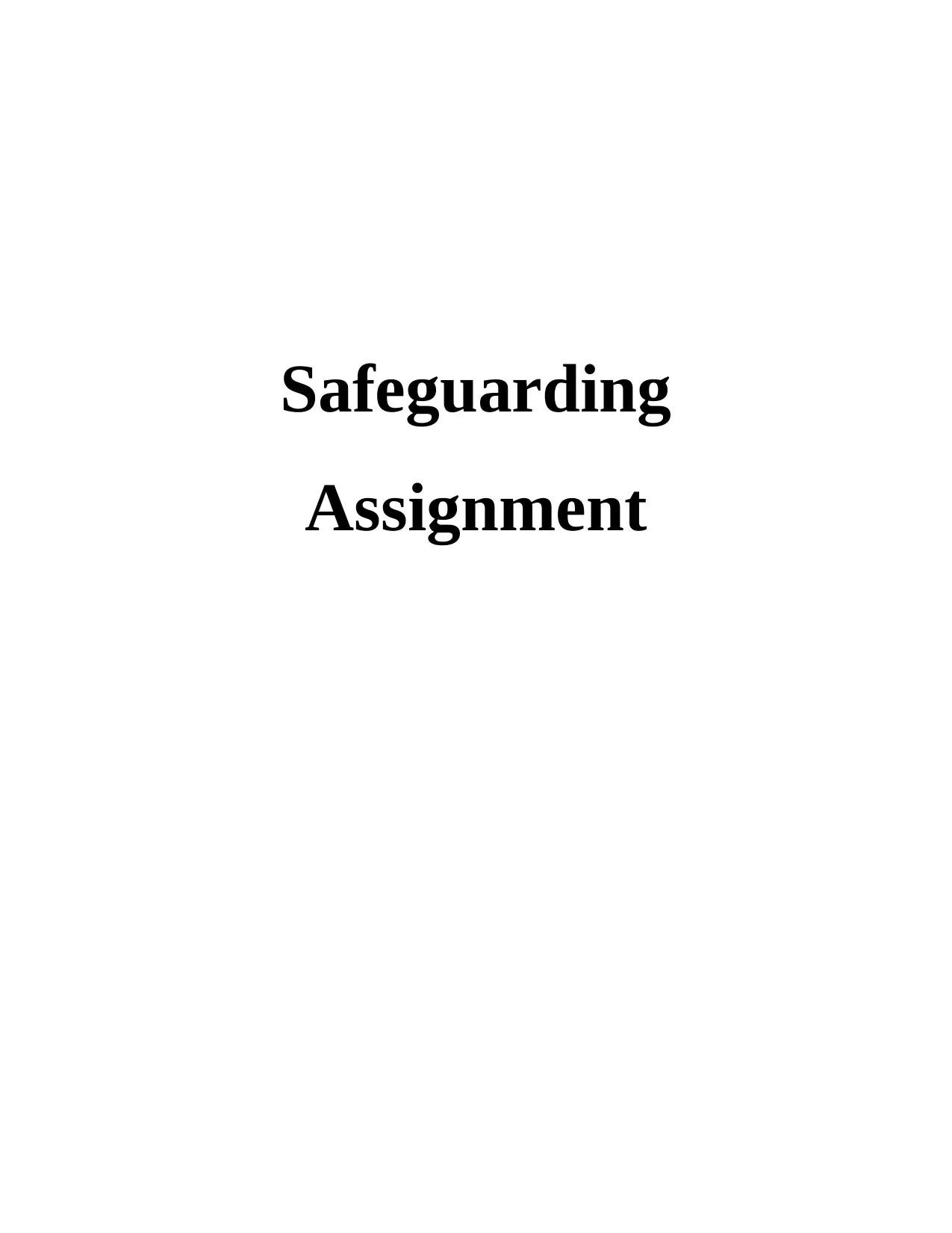
Safeguarding
Assignment
Assignment
Paraphrase This Document
Need a fresh take? Get an instant paraphrase of this document with our AI Paraphraser
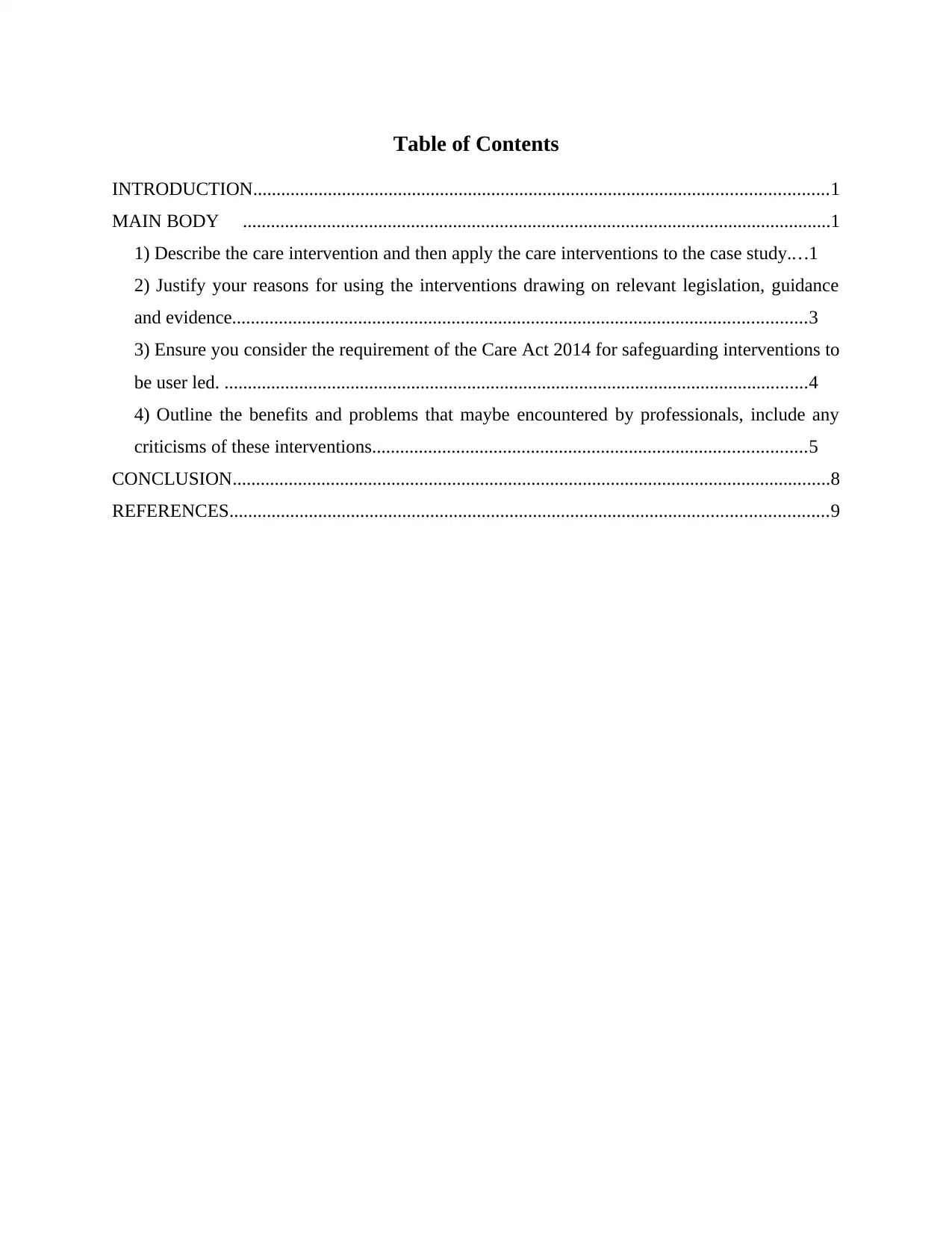
Table of Contents
INTRODUCTION...........................................................................................................................1
MAIN BODY ..............................................................................................................................1
1) Describe the care intervention and then apply the care interventions to the case study....1
2) Justify your reasons for using the interventions drawing on relevant legislation, guidance
and evidence...........................................................................................................................3
3) Ensure you consider the requirement of the Care Act 2014 for safeguarding interventions to
be user led. .............................................................................................................................4
4) Outline the benefits and problems that maybe encountered by professionals, include any
criticisms of these interventions.............................................................................................5
CONCLUSION................................................................................................................................8
REFERENCES................................................................................................................................9
INTRODUCTION...........................................................................................................................1
MAIN BODY ..............................................................................................................................1
1) Describe the care intervention and then apply the care interventions to the case study....1
2) Justify your reasons for using the interventions drawing on relevant legislation, guidance
and evidence...........................................................................................................................3
3) Ensure you consider the requirement of the Care Act 2014 for safeguarding interventions to
be user led. .............................................................................................................................4
4) Outline the benefits and problems that maybe encountered by professionals, include any
criticisms of these interventions.............................................................................................5
CONCLUSION................................................................................................................................8
REFERENCES................................................................................................................................9
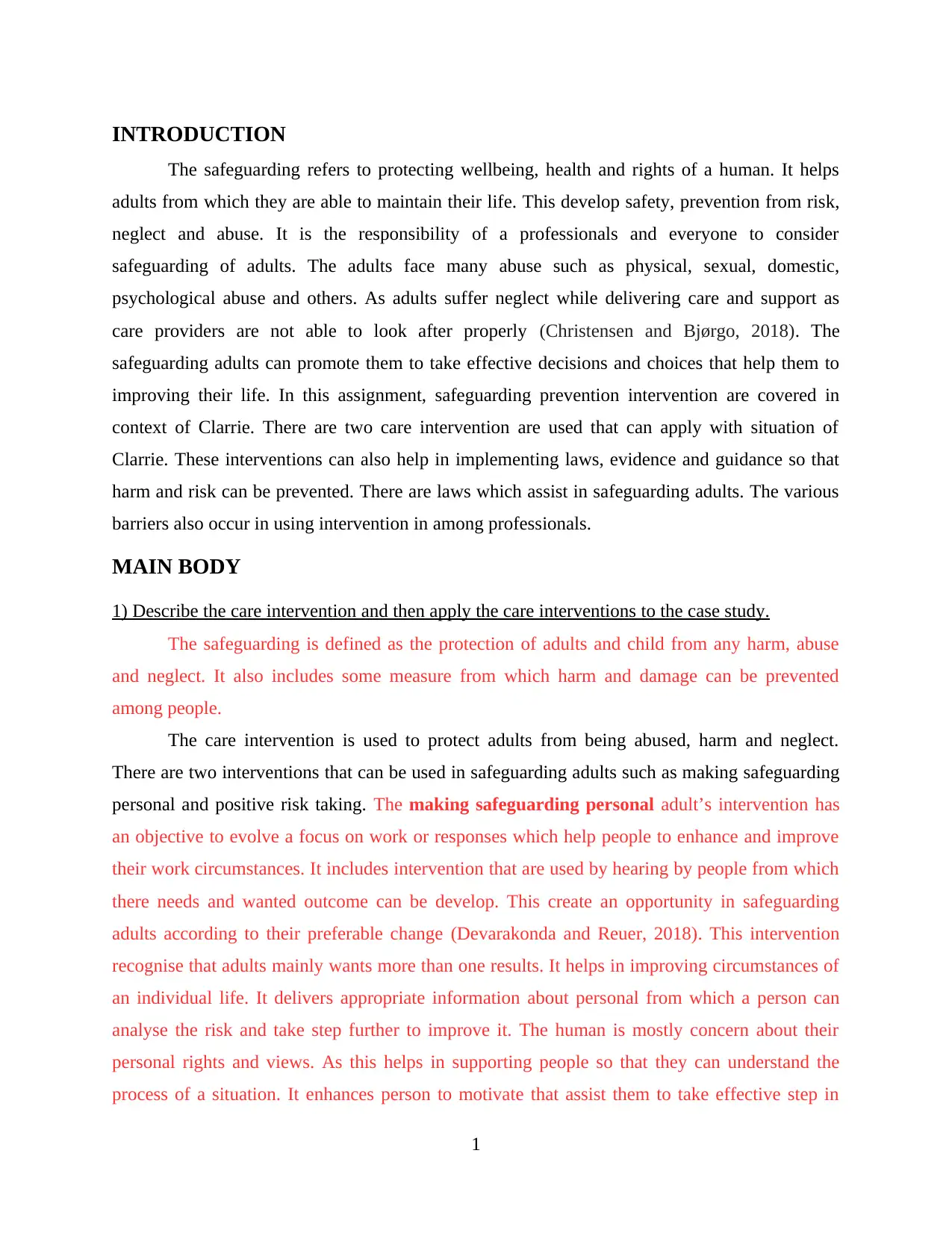
INTRODUCTION
The safeguarding refers to protecting wellbeing, health and rights of a human. It helps
adults from which they are able to maintain their life. This develop safety, prevention from risk,
neglect and abuse. It is the responsibility of a professionals and everyone to consider
safeguarding of adults. The adults face many abuse such as physical, sexual, domestic,
psychological abuse and others. As adults suffer neglect while delivering care and support as
care providers are not able to look after properly (Christensen and Bjørgo, 2018). The
safeguarding adults can promote them to take effective decisions and choices that help them to
improving their life. In this assignment, safeguarding prevention intervention are covered in
context of Clarrie. There are two care intervention are used that can apply with situation of
Clarrie. These interventions can also help in implementing laws, evidence and guidance so that
harm and risk can be prevented. There are laws which assist in safeguarding adults. The various
barriers also occur in using intervention in among professionals.
MAIN BODY
1) Describe the care intervention and then apply the care interventions to the case study.
The safeguarding is defined as the protection of adults and child from any harm, abuse
and neglect. It also includes some measure from which harm and damage can be prevented
among people.
The care intervention is used to protect adults from being abused, harm and neglect.
There are two interventions that can be used in safeguarding adults such as making safeguarding
personal and positive risk taking. The making safeguarding personal adult’s intervention has
an objective to evolve a focus on work or responses which help people to enhance and improve
their work circumstances. It includes intervention that are used by hearing by people from which
there needs and wanted outcome can be develop. This create an opportunity in safeguarding
adults according to their preferable change (Devarakonda and Reuer, 2018). This intervention
recognise that adults mainly wants more than one results. It helps in improving circumstances of
an individual life. It delivers appropriate information about personal from which a person can
analyse the risk and take step further to improve it. The human is mostly concern about their
personal rights and views. As this helps in supporting people so that they can understand the
process of a situation. It enhances person to motivate that assist them to take effective step in
1
The safeguarding refers to protecting wellbeing, health and rights of a human. It helps
adults from which they are able to maintain their life. This develop safety, prevention from risk,
neglect and abuse. It is the responsibility of a professionals and everyone to consider
safeguarding of adults. The adults face many abuse such as physical, sexual, domestic,
psychological abuse and others. As adults suffer neglect while delivering care and support as
care providers are not able to look after properly (Christensen and Bjørgo, 2018). The
safeguarding adults can promote them to take effective decisions and choices that help them to
improving their life. In this assignment, safeguarding prevention intervention are covered in
context of Clarrie. There are two care intervention are used that can apply with situation of
Clarrie. These interventions can also help in implementing laws, evidence and guidance so that
harm and risk can be prevented. There are laws which assist in safeguarding adults. The various
barriers also occur in using intervention in among professionals.
MAIN BODY
1) Describe the care intervention and then apply the care interventions to the case study.
The safeguarding is defined as the protection of adults and child from any harm, abuse
and neglect. It also includes some measure from which harm and damage can be prevented
among people.
The care intervention is used to protect adults from being abused, harm and neglect.
There are two interventions that can be used in safeguarding adults such as making safeguarding
personal and positive risk taking. The making safeguarding personal adult’s intervention has
an objective to evolve a focus on work or responses which help people to enhance and improve
their work circumstances. It includes intervention that are used by hearing by people from which
there needs and wanted outcome can be develop. This create an opportunity in safeguarding
adults according to their preferable change (Devarakonda and Reuer, 2018). This intervention
recognise that adults mainly wants more than one results. It helps in improving circumstances of
an individual life. It delivers appropriate information about personal from which a person can
analyse the risk and take step further to improve it. The human is mostly concern about their
personal rights and views. As this helps in supporting people so that they can understand the
process of a situation. It enhances person to motivate that assist them to take effective step in
1
⊘ This is a preview!⊘
Do you want full access?
Subscribe today to unlock all pages.

Trusted by 1+ million students worldwide
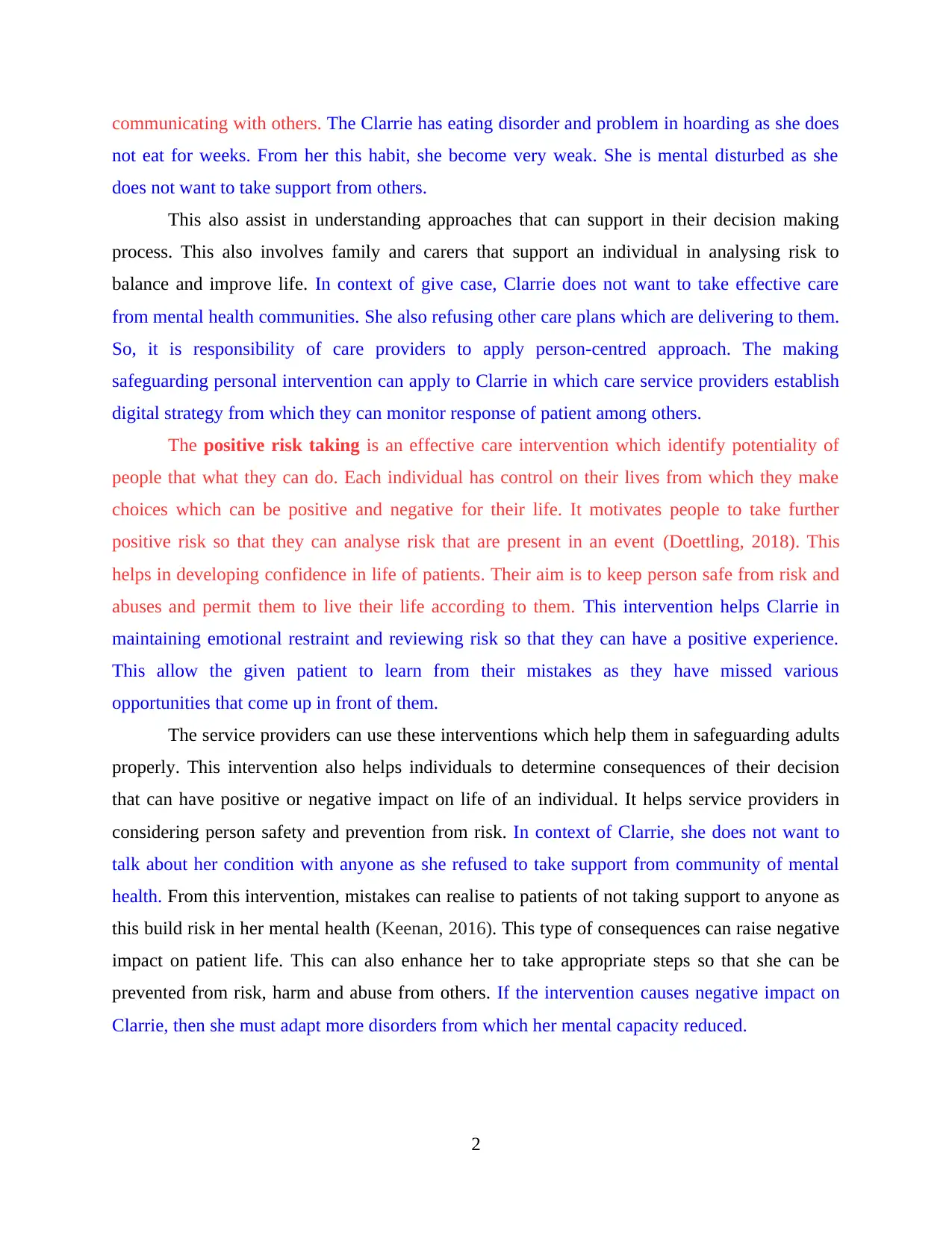
communicating with others. The Clarrie has eating disorder and problem in hoarding as she does
not eat for weeks. From her this habit, she become very weak. She is mental disturbed as she
does not want to take support from others.
This also assist in understanding approaches that can support in their decision making
process. This also involves family and carers that support an individual in analysing risk to
balance and improve life. In context of give case, Clarrie does not want to take effective care
from mental health communities. She also refusing other care plans which are delivering to them.
So, it is responsibility of care providers to apply person-centred approach. The making
safeguarding personal intervention can apply to Clarrie in which care service providers establish
digital strategy from which they can monitor response of patient among others.
The positive risk taking is an effective care intervention which identify potentiality of
people that what they can do. Each individual has control on their lives from which they make
choices which can be positive and negative for their life. It motivates people to take further
positive risk so that they can analyse risk that are present in an event (Doettling, 2018). This
helps in developing confidence in life of patients. Their aim is to keep person safe from risk and
abuses and permit them to live their life according to them. This intervention helps Clarrie in
maintaining emotional restraint and reviewing risk so that they can have a positive experience.
This allow the given patient to learn from their mistakes as they have missed various
opportunities that come up in front of them.
The service providers can use these interventions which help them in safeguarding adults
properly. This intervention also helps individuals to determine consequences of their decision
that can have positive or negative impact on life of an individual. It helps service providers in
considering person safety and prevention from risk. In context of Clarrie, she does not want to
talk about her condition with anyone as she refused to take support from community of mental
health. From this intervention, mistakes can realise to patients of not taking support to anyone as
this build risk in her mental health (Keenan, 2016). This type of consequences can raise negative
impact on patient life. This can also enhance her to take appropriate steps so that she can be
prevented from risk, harm and abuse from others. If the intervention causes negative impact on
Clarrie, then she must adapt more disorders from which her mental capacity reduced.
2
not eat for weeks. From her this habit, she become very weak. She is mental disturbed as she
does not want to take support from others.
This also assist in understanding approaches that can support in their decision making
process. This also involves family and carers that support an individual in analysing risk to
balance and improve life. In context of give case, Clarrie does not want to take effective care
from mental health communities. She also refusing other care plans which are delivering to them.
So, it is responsibility of care providers to apply person-centred approach. The making
safeguarding personal intervention can apply to Clarrie in which care service providers establish
digital strategy from which they can monitor response of patient among others.
The positive risk taking is an effective care intervention which identify potentiality of
people that what they can do. Each individual has control on their lives from which they make
choices which can be positive and negative for their life. It motivates people to take further
positive risk so that they can analyse risk that are present in an event (Doettling, 2018). This
helps in developing confidence in life of patients. Their aim is to keep person safe from risk and
abuses and permit them to live their life according to them. This intervention helps Clarrie in
maintaining emotional restraint and reviewing risk so that they can have a positive experience.
This allow the given patient to learn from their mistakes as they have missed various
opportunities that come up in front of them.
The service providers can use these interventions which help them in safeguarding adults
properly. This intervention also helps individuals to determine consequences of their decision
that can have positive or negative impact on life of an individual. It helps service providers in
considering person safety and prevention from risk. In context of Clarrie, she does not want to
talk about her condition with anyone as she refused to take support from community of mental
health. From this intervention, mistakes can realise to patients of not taking support to anyone as
this build risk in her mental health (Keenan, 2016). This type of consequences can raise negative
impact on patient life. This can also enhance her to take appropriate steps so that she can be
prevented from risk, harm and abuse from others. If the intervention causes negative impact on
Clarrie, then she must adapt more disorders from which her mental capacity reduced.
2
Paraphrase This Document
Need a fresh take? Get an instant paraphrase of this document with our AI Paraphraser
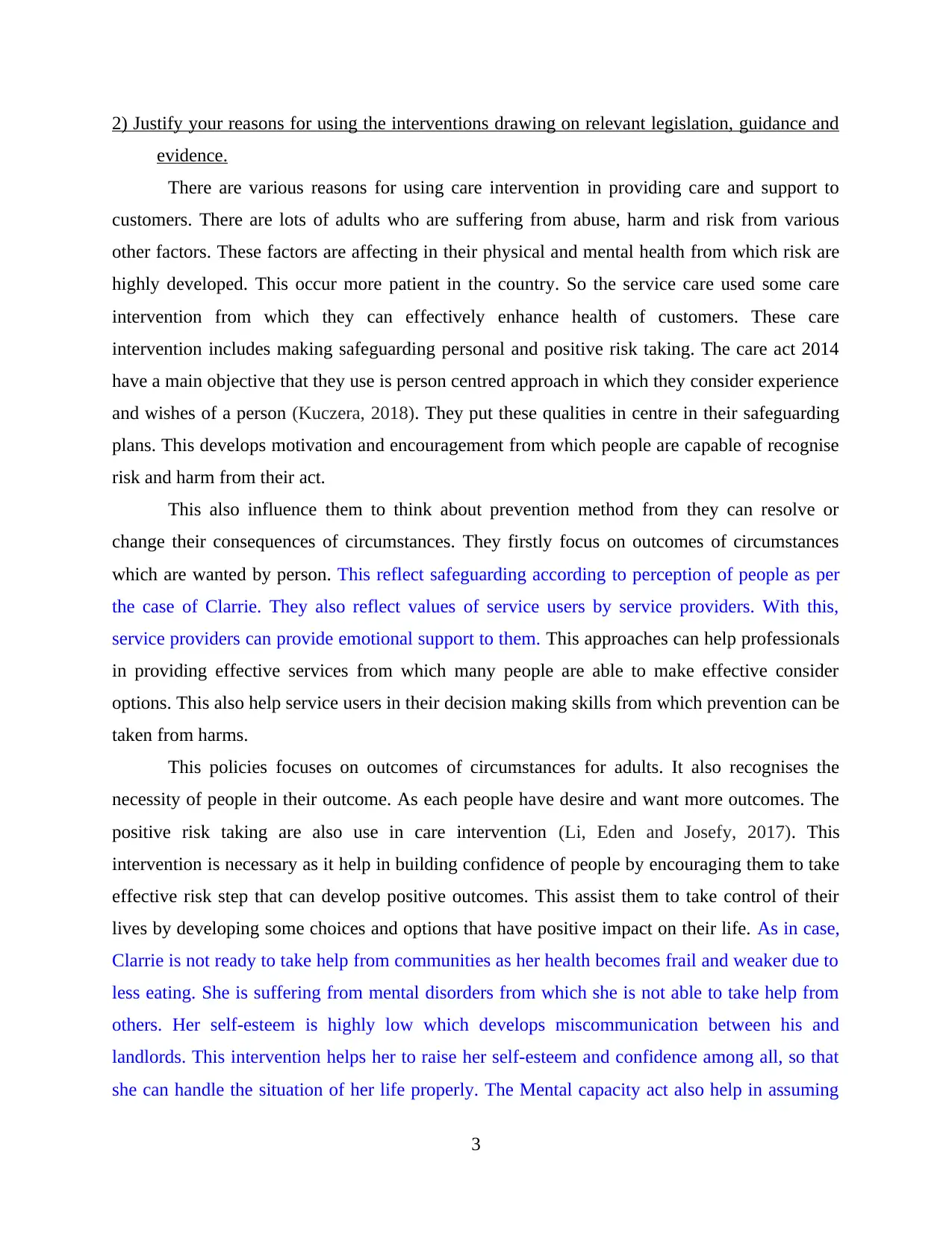
2) Justify your reasons for using the interventions drawing on relevant legislation, guidance and
evidence.
There are various reasons for using care intervention in providing care and support to
customers. There are lots of adults who are suffering from abuse, harm and risk from various
other factors. These factors are affecting in their physical and mental health from which risk are
highly developed. This occur more patient in the country. So the service care used some care
intervention from which they can effectively enhance health of customers. These care
intervention includes making safeguarding personal and positive risk taking. The care act 2014
have a main objective that they use is person centred approach in which they consider experience
and wishes of a person (Kuczera, 2018). They put these qualities in centre in their safeguarding
plans. This develops motivation and encouragement from which people are capable of recognise
risk and harm from their act.
This also influence them to think about prevention method from they can resolve or
change their consequences of circumstances. They firstly focus on outcomes of circumstances
which are wanted by person. This reflect safeguarding according to perception of people as per
the case of Clarrie. They also reflect values of service users by service providers. With this,
service providers can provide emotional support to them. This approaches can help professionals
in providing effective services from which many people are able to make effective consider
options. This also help service users in their decision making skills from which prevention can be
taken from harms.
This policies focuses on outcomes of circumstances for adults. It also recognises the
necessity of people in their outcome. As each people have desire and want more outcomes. The
positive risk taking are also use in care intervention (Li, Eden and Josefy, 2017). This
intervention is necessary as it help in building confidence of people by encouraging them to take
effective risk step that can develop positive outcomes. This assist them to take control of their
lives by developing some choices and options that have positive impact on their life. As in case,
Clarrie is not ready to take help from communities as her health becomes frail and weaker due to
less eating. She is suffering from mental disorders from which she is not able to take help from
others. Her self-esteem is highly low which develops miscommunication between his and
landlords. This intervention helps her to raise her self-esteem and confidence among all, so that
she can handle the situation of her life properly. The Mental capacity act also help in assuming
3
evidence.
There are various reasons for using care intervention in providing care and support to
customers. There are lots of adults who are suffering from abuse, harm and risk from various
other factors. These factors are affecting in their physical and mental health from which risk are
highly developed. This occur more patient in the country. So the service care used some care
intervention from which they can effectively enhance health of customers. These care
intervention includes making safeguarding personal and positive risk taking. The care act 2014
have a main objective that they use is person centred approach in which they consider experience
and wishes of a person (Kuczera, 2018). They put these qualities in centre in their safeguarding
plans. This develops motivation and encouragement from which people are capable of recognise
risk and harm from their act.
This also influence them to think about prevention method from they can resolve or
change their consequences of circumstances. They firstly focus on outcomes of circumstances
which are wanted by person. This reflect safeguarding according to perception of people as per
the case of Clarrie. They also reflect values of service users by service providers. With this,
service providers can provide emotional support to them. This approaches can help professionals
in providing effective services from which many people are able to make effective consider
options. This also help service users in their decision making skills from which prevention can be
taken from harms.
This policies focuses on outcomes of circumstances for adults. It also recognises the
necessity of people in their outcome. As each people have desire and want more outcomes. The
positive risk taking are also use in care intervention (Li, Eden and Josefy, 2017). This
intervention is necessary as it help in building confidence of people by encouraging them to take
effective risk step that can develop positive outcomes. This assist them to take control of their
lives by developing some choices and options that have positive impact on their life. As in case,
Clarrie is not ready to take help from communities as her health becomes frail and weaker due to
less eating. She is suffering from mental disorders from which she is not able to take help from
others. Her self-esteem is highly low which develops miscommunication between his and
landlords. This intervention helps her to raise her self-esteem and confidence among all, so that
she can handle the situation of her life properly. The Mental capacity act also help in assuming
3
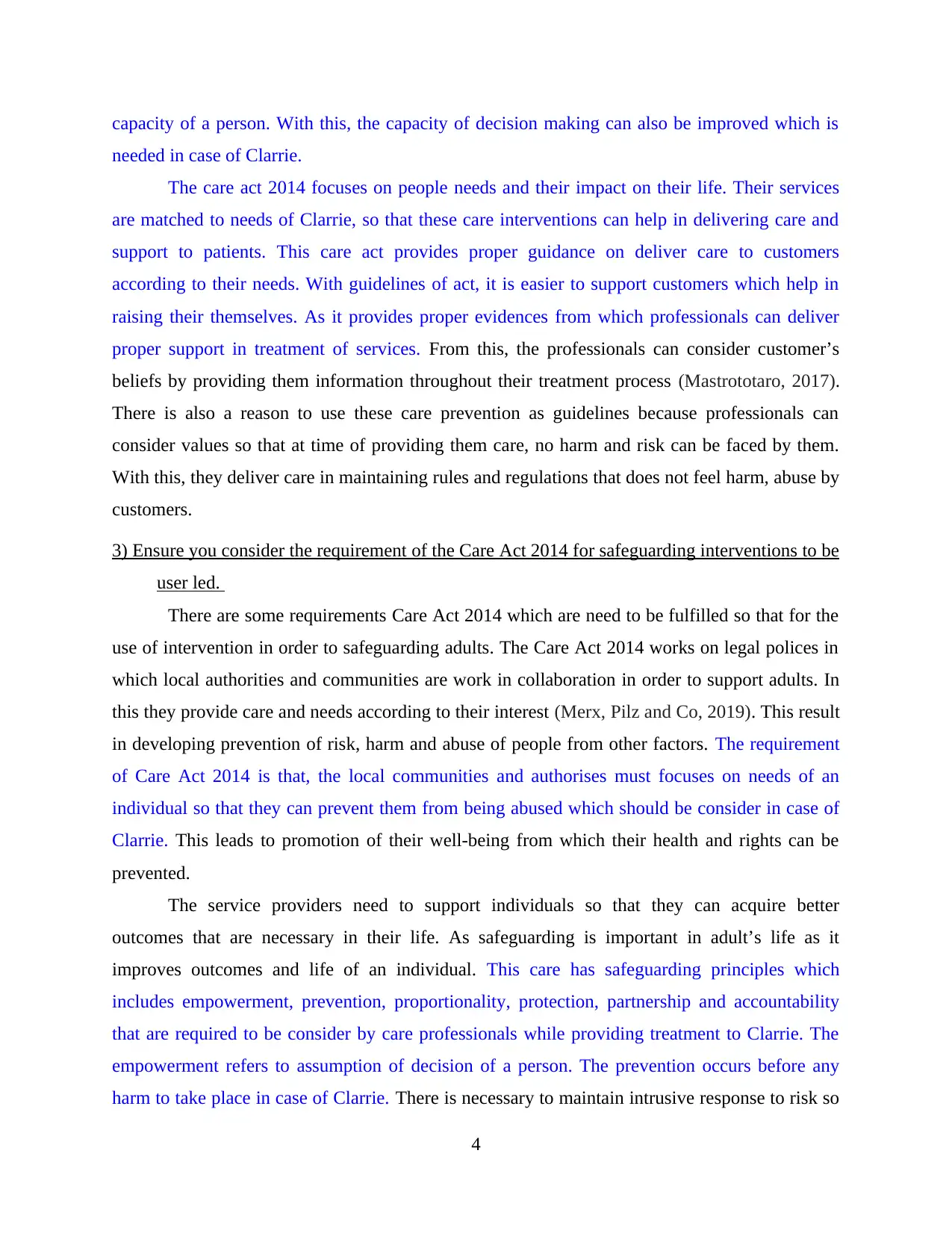
capacity of a person. With this, the capacity of decision making can also be improved which is
needed in case of Clarrie.
The care act 2014 focuses on people needs and their impact on their life. Their services
are matched to needs of Clarrie, so that these care interventions can help in delivering care and
support to patients. This care act provides proper guidance on deliver care to customers
according to their needs. With guidelines of act, it is easier to support customers which help in
raising their themselves. As it provides proper evidences from which professionals can deliver
proper support in treatment of services. From this, the professionals can consider customer’s
beliefs by providing them information throughout their treatment process (Mastrototaro, 2017).
There is also a reason to use these care prevention as guidelines because professionals can
consider values so that at time of providing them care, no harm and risk can be faced by them.
With this, they deliver care in maintaining rules and regulations that does not feel harm, abuse by
customers.
3) Ensure you consider the requirement of the Care Act 2014 for safeguarding interventions to be
user led.
There are some requirements Care Act 2014 which are need to be fulfilled so that for the
use of intervention in order to safeguarding adults. The Care Act 2014 works on legal polices in
which local authorities and communities are work in collaboration in order to support adults. In
this they provide care and needs according to their interest (Merx, Pilz and Co, 2019). This result
in developing prevention of risk, harm and abuse of people from other factors. The requirement
of Care Act 2014 is that, the local communities and authorises must focuses on needs of an
individual so that they can prevent them from being abused which should be consider in case of
Clarrie. This leads to promotion of their well-being from which their health and rights can be
prevented.
The service providers need to support individuals so that they can acquire better
outcomes that are necessary in their life. As safeguarding is important in adult’s life as it
improves outcomes and life of an individual. This care has safeguarding principles which
includes empowerment, prevention, proportionality, protection, partnership and accountability
that are required to be consider by care professionals while providing treatment to Clarrie. The
empowerment refers to assumption of decision of a person. The prevention occurs before any
harm to take place in case of Clarrie. There is necessary to maintain intrusive response to risk so
4
needed in case of Clarrie.
The care act 2014 focuses on people needs and their impact on their life. Their services
are matched to needs of Clarrie, so that these care interventions can help in delivering care and
support to patients. This care act provides proper guidance on deliver care to customers
according to their needs. With guidelines of act, it is easier to support customers which help in
raising their themselves. As it provides proper evidences from which professionals can deliver
proper support in treatment of services. From this, the professionals can consider customer’s
beliefs by providing them information throughout their treatment process (Mastrototaro, 2017).
There is also a reason to use these care prevention as guidelines because professionals can
consider values so that at time of providing them care, no harm and risk can be faced by them.
With this, they deliver care in maintaining rules and regulations that does not feel harm, abuse by
customers.
3) Ensure you consider the requirement of the Care Act 2014 for safeguarding interventions to be
user led.
There are some requirements Care Act 2014 which are need to be fulfilled so that for the
use of intervention in order to safeguarding adults. The Care Act 2014 works on legal polices in
which local authorities and communities are work in collaboration in order to support adults. In
this they provide care and needs according to their interest (Merx, Pilz and Co, 2019). This result
in developing prevention of risk, harm and abuse of people from other factors. The requirement
of Care Act 2014 is that, the local communities and authorises must focuses on needs of an
individual so that they can prevent them from being abused which should be consider in case of
Clarrie. This leads to promotion of their well-being from which their health and rights can be
prevented.
The service providers need to support individuals so that they can acquire better
outcomes that are necessary in their life. As safeguarding is important in adult’s life as it
improves outcomes and life of an individual. This care has safeguarding principles which
includes empowerment, prevention, proportionality, protection, partnership and accountability
that are required to be consider by care professionals while providing treatment to Clarrie. The
empowerment refers to assumption of decision of a person. The prevention occurs before any
harm to take place in case of Clarrie. There is necessary to maintain intrusive response to risk so
4
⊘ This is a preview!⊘
Do you want full access?
Subscribe today to unlock all pages.

Trusted by 1+ million students worldwide
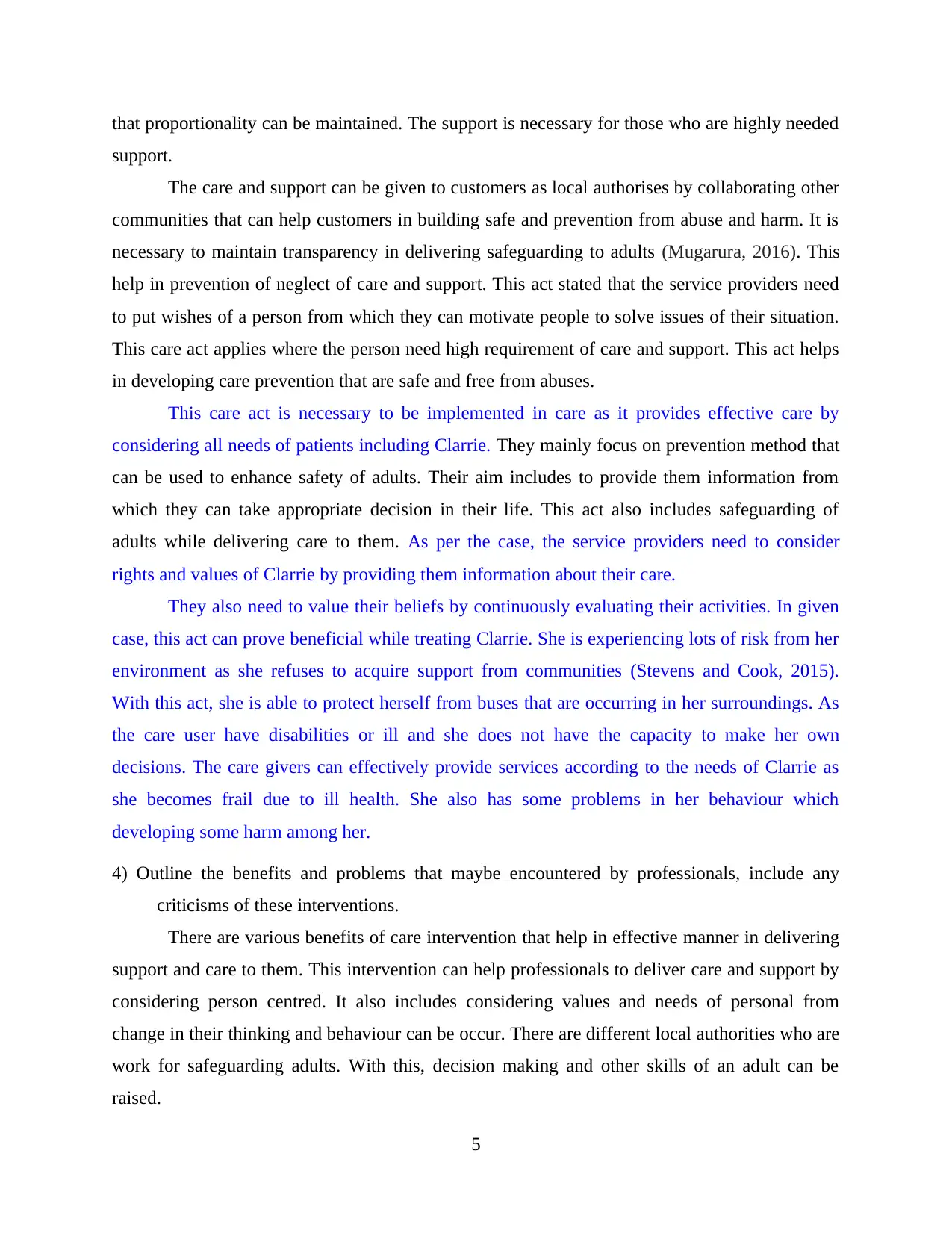
that proportionality can be maintained. The support is necessary for those who are highly needed
support.
The care and support can be given to customers as local authorises by collaborating other
communities that can help customers in building safe and prevention from abuse and harm. It is
necessary to maintain transparency in delivering safeguarding to adults (Mugarura, 2016). This
help in prevention of neglect of care and support. This act stated that the service providers need
to put wishes of a person from which they can motivate people to solve issues of their situation.
This care act applies where the person need high requirement of care and support. This act helps
in developing care prevention that are safe and free from abuses.
This care act is necessary to be implemented in care as it provides effective care by
considering all needs of patients including Clarrie. They mainly focus on prevention method that
can be used to enhance safety of adults. Their aim includes to provide them information from
which they can take appropriate decision in their life. This act also includes safeguarding of
adults while delivering care to them. As per the case, the service providers need to consider
rights and values of Clarrie by providing them information about their care.
They also need to value their beliefs by continuously evaluating their activities. In given
case, this act can prove beneficial while treating Clarrie. She is experiencing lots of risk from her
environment as she refuses to acquire support from communities (Stevens and Cook, 2015).
With this act, she is able to protect herself from buses that are occurring in her surroundings. As
the care user have disabilities or ill and she does not have the capacity to make her own
decisions. The care givers can effectively provide services according to the needs of Clarrie as
she becomes frail due to ill health. She also has some problems in her behaviour which
developing some harm among her.
4) Outline the benefits and problems that maybe encountered by professionals, include any
criticisms of these interventions.
There are various benefits of care intervention that help in effective manner in delivering
support and care to them. This intervention can help professionals to deliver care and support by
considering person centred. It also includes considering values and needs of personal from
change in their thinking and behaviour can be occur. There are different local authorities who are
work for safeguarding adults. With this, decision making and other skills of an adult can be
raised.
5
support.
The care and support can be given to customers as local authorises by collaborating other
communities that can help customers in building safe and prevention from abuse and harm. It is
necessary to maintain transparency in delivering safeguarding to adults (Mugarura, 2016). This
help in prevention of neglect of care and support. This act stated that the service providers need
to put wishes of a person from which they can motivate people to solve issues of their situation.
This care act applies where the person need high requirement of care and support. This act helps
in developing care prevention that are safe and free from abuses.
This care act is necessary to be implemented in care as it provides effective care by
considering all needs of patients including Clarrie. They mainly focus on prevention method that
can be used to enhance safety of adults. Their aim includes to provide them information from
which they can take appropriate decision in their life. This act also includes safeguarding of
adults while delivering care to them. As per the case, the service providers need to consider
rights and values of Clarrie by providing them information about their care.
They also need to value their beliefs by continuously evaluating their activities. In given
case, this act can prove beneficial while treating Clarrie. She is experiencing lots of risk from her
environment as she refuses to acquire support from communities (Stevens and Cook, 2015).
With this act, she is able to protect herself from buses that are occurring in her surroundings. As
the care user have disabilities or ill and she does not have the capacity to make her own
decisions. The care givers can effectively provide services according to the needs of Clarrie as
she becomes frail due to ill health. She also has some problems in her behaviour which
developing some harm among her.
4) Outline the benefits and problems that maybe encountered by professionals, include any
criticisms of these interventions.
There are various benefits of care intervention that help in effective manner in delivering
support and care to them. This intervention can help professionals to deliver care and support by
considering person centred. It also includes considering values and needs of personal from
change in their thinking and behaviour can be occur. There are different local authorities who are
work for safeguarding adults. With this, decision making and other skills of an adult can be
raised.
5
Paraphrase This Document
Need a fresh take? Get an instant paraphrase of this document with our AI Paraphraser
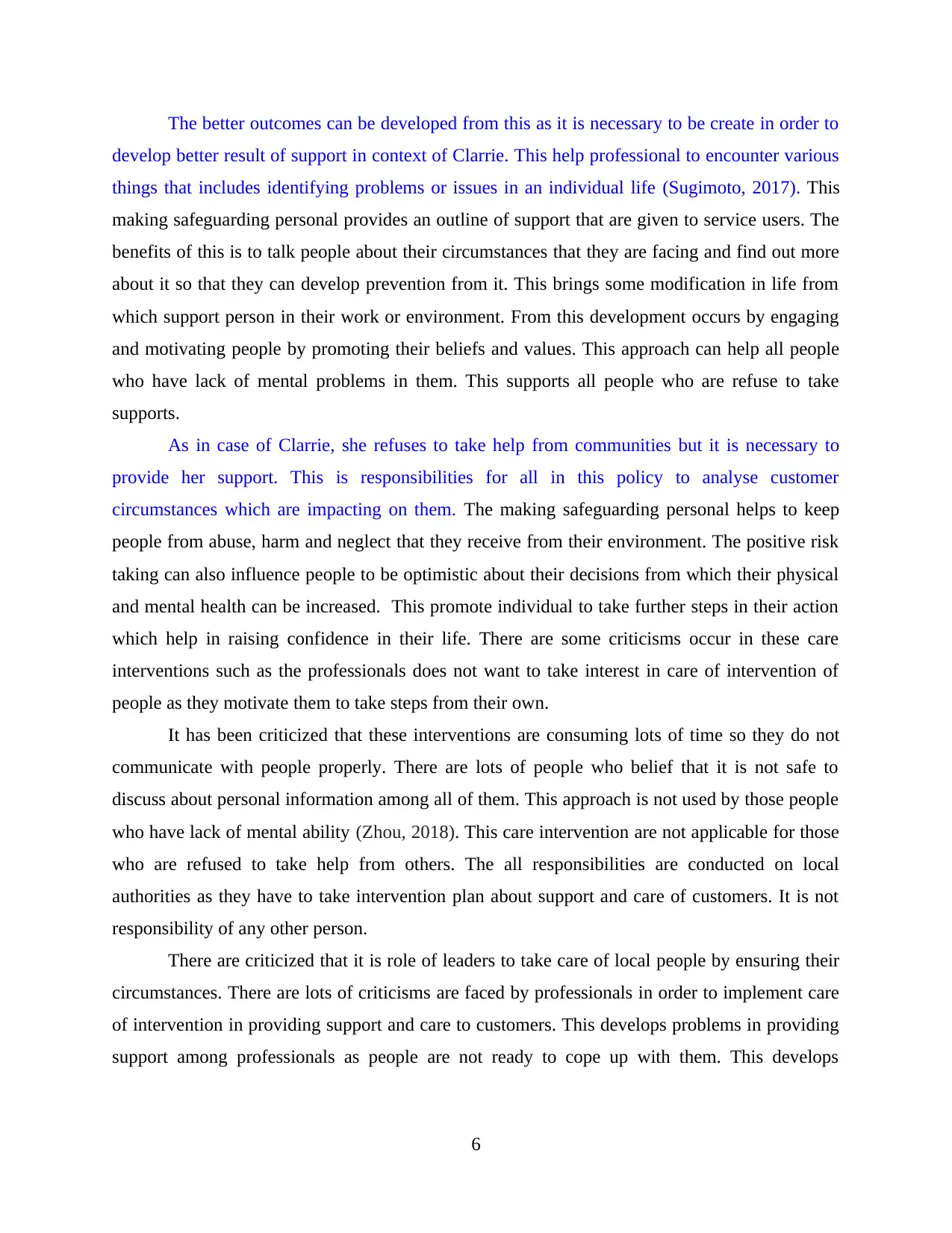
The better outcomes can be developed from this as it is necessary to be create in order to
develop better result of support in context of Clarrie. This help professional to encounter various
things that includes identifying problems or issues in an individual life (Sugimoto, 2017). This
making safeguarding personal provides an outline of support that are given to service users. The
benefits of this is to talk people about their circumstances that they are facing and find out more
about it so that they can develop prevention from it. This brings some modification in life from
which support person in their work or environment. From this development occurs by engaging
and motivating people by promoting their beliefs and values. This approach can help all people
who have lack of mental problems in them. This supports all people who are refuse to take
supports.
As in case of Clarrie, she refuses to take help from communities but it is necessary to
provide her support. This is responsibilities for all in this policy to analyse customer
circumstances which are impacting on them. The making safeguarding personal helps to keep
people from abuse, harm and neglect that they receive from their environment. The positive risk
taking can also influence people to be optimistic about their decisions from which their physical
and mental health can be increased. This promote individual to take further steps in their action
which help in raising confidence in their life. There are some criticisms occur in these care
interventions such as the professionals does not want to take interest in care of intervention of
people as they motivate them to take steps from their own.
It has been criticized that these interventions are consuming lots of time so they do not
communicate with people properly. There are lots of people who belief that it is not safe to
discuss about personal information among all of them. This approach is not used by those people
who have lack of mental ability (Zhou, 2018). This care intervention are not applicable for those
who are refused to take help from others. The all responsibilities are conducted on local
authorities as they have to take intervention plan about support and care of customers. It is not
responsibility of any other person.
There are criticized that it is role of leaders to take care of local people by ensuring their
circumstances. There are lots of criticisms are faced by professionals in order to implement care
of intervention in providing support and care to customers. This develops problems in providing
support among professionals as people are not ready to cope up with them. This develops
6
develop better result of support in context of Clarrie. This help professional to encounter various
things that includes identifying problems or issues in an individual life (Sugimoto, 2017). This
making safeguarding personal provides an outline of support that are given to service users. The
benefits of this is to talk people about their circumstances that they are facing and find out more
about it so that they can develop prevention from it. This brings some modification in life from
which support person in their work or environment. From this development occurs by engaging
and motivating people by promoting their beliefs and values. This approach can help all people
who have lack of mental problems in them. This supports all people who are refuse to take
supports.
As in case of Clarrie, she refuses to take help from communities but it is necessary to
provide her support. This is responsibilities for all in this policy to analyse customer
circumstances which are impacting on them. The making safeguarding personal helps to keep
people from abuse, harm and neglect that they receive from their environment. The positive risk
taking can also influence people to be optimistic about their decisions from which their physical
and mental health can be increased. This promote individual to take further steps in their action
which help in raising confidence in their life. There are some criticisms occur in these care
interventions such as the professionals does not want to take interest in care of intervention of
people as they motivate them to take steps from their own.
It has been criticized that these interventions are consuming lots of time so they do not
communicate with people properly. There are lots of people who belief that it is not safe to
discuss about personal information among all of them. This approach is not used by those people
who have lack of mental ability (Zhou, 2018). This care intervention are not applicable for those
who are refused to take help from others. The all responsibilities are conducted on local
authorities as they have to take intervention plan about support and care of customers. It is not
responsibility of any other person.
There are criticized that it is role of leaders to take care of local people by ensuring their
circumstances. There are lots of criticisms are faced by professionals in order to implement care
of intervention in providing support and care to customers. This develops problems in providing
support among professionals as people are not ready to cope up with them. This develops
6

negative impact of physical and mental on patient’s body and harm, risk and abuses occur on
them. It reduces the aim of safeguarding adults in front of local authorities and professionals.
7
them. It reduces the aim of safeguarding adults in front of local authorities and professionals.
7
⊘ This is a preview!⊘
Do you want full access?
Subscribe today to unlock all pages.

Trusted by 1+ million students worldwide
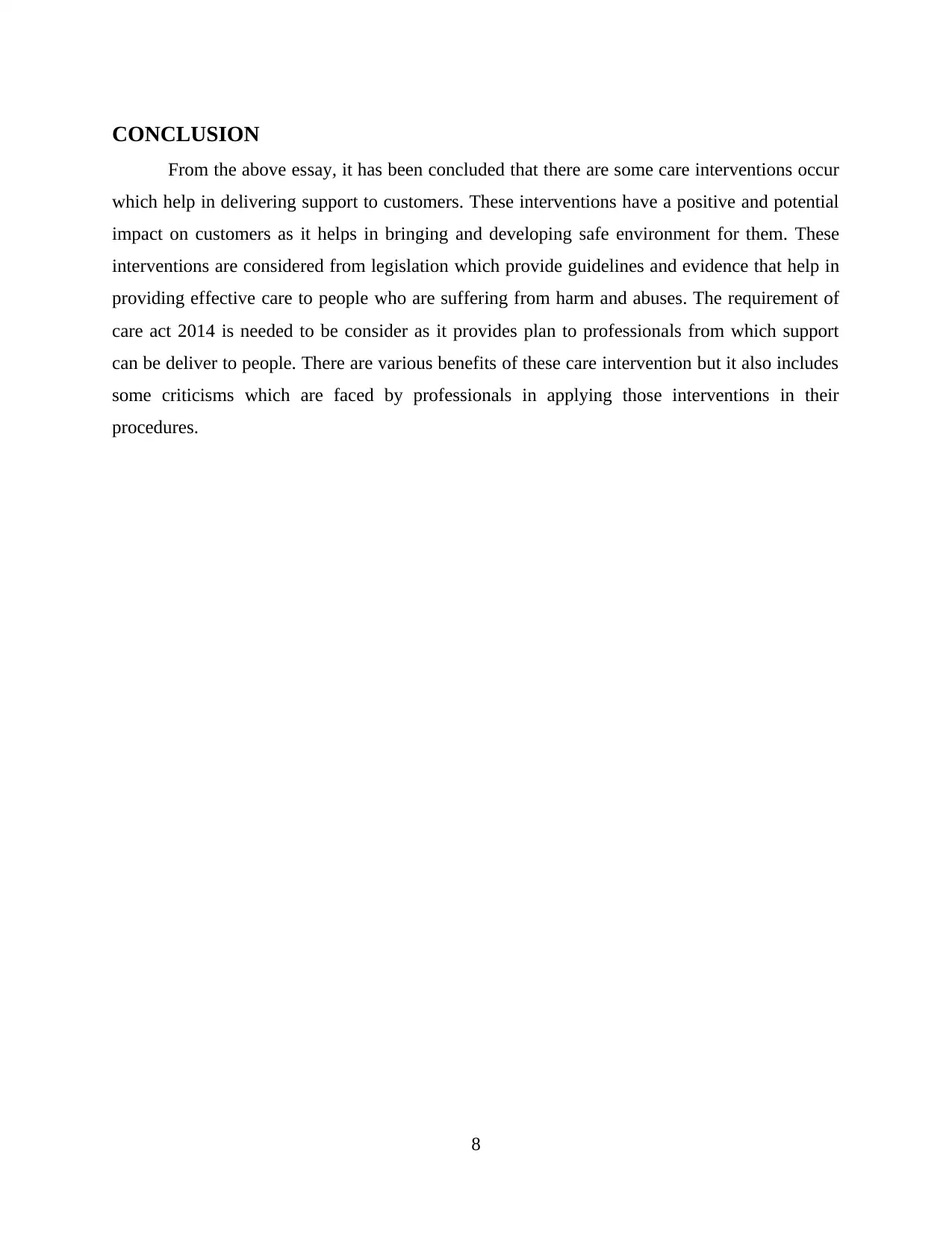
CONCLUSION
From the above essay, it has been concluded that there are some care interventions occur
which help in delivering support to customers. These interventions have a positive and potential
impact on customers as it helps in bringing and developing safe environment for them. These
interventions are considered from legislation which provide guidelines and evidence that help in
providing effective care to people who are suffering from harm and abuses. The requirement of
care act 2014 is needed to be consider as it provides plan to professionals from which support
can be deliver to people. There are various benefits of these care intervention but it also includes
some criticisms which are faced by professionals in applying those interventions in their
procedures.
8
From the above essay, it has been concluded that there are some care interventions occur
which help in delivering support to customers. These interventions have a positive and potential
impact on customers as it helps in bringing and developing safe environment for them. These
interventions are considered from legislation which provide guidelines and evidence that help in
providing effective care to people who are suffering from harm and abuses. The requirement of
care act 2014 is needed to be consider as it provides plan to professionals from which support
can be deliver to people. There are various benefits of these care intervention but it also includes
some criticisms which are faced by professionals in applying those interventions in their
procedures.
8
Paraphrase This Document
Need a fresh take? Get an instant paraphrase of this document with our AI Paraphraser
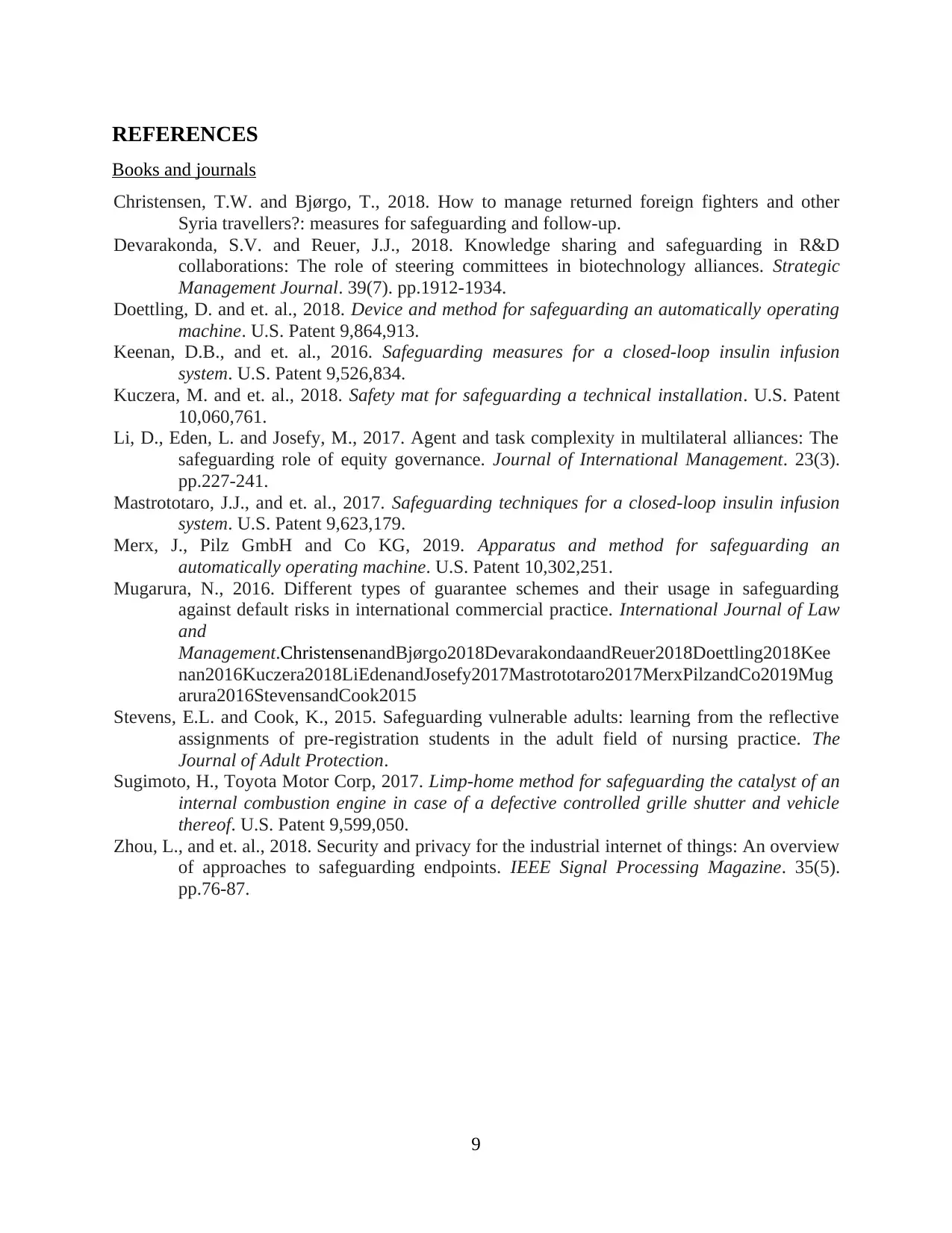
REFERENCES
Books and journals
Christensen, T.W. and Bjørgo, T., 2018. How to manage returned foreign fighters and other
Syria travellers?: measures for safeguarding and follow-up.
Devarakonda, S.V. and Reuer, J.J., 2018. Knowledge sharing and safeguarding in R&D
collaborations: The role of steering committees in biotechnology alliances. Strategic
Management Journal. 39(7). pp.1912-1934.
Doettling, D. and et. al., 2018. Device and method for safeguarding an automatically operating
machine. U.S. Patent 9,864,913.
Keenan, D.B., and et. al., 2016. Safeguarding measures for a closed-loop insulin infusion
system. U.S. Patent 9,526,834.
Kuczera, M. and et. al., 2018. Safety mat for safeguarding a technical installation. U.S. Patent
10,060,761.
Li, D., Eden, L. and Josefy, M., 2017. Agent and task complexity in multilateral alliances: The
safeguarding role of equity governance. Journal of International Management. 23(3).
pp.227-241.
Mastrototaro, J.J., and et. al., 2017. Safeguarding techniques for a closed-loop insulin infusion
system. U.S. Patent 9,623,179.
Merx, J., Pilz GmbH and Co KG, 2019. Apparatus and method for safeguarding an
automatically operating machine. U.S. Patent 10,302,251.
Mugarura, N., 2016. Different types of guarantee schemes and their usage in safeguarding
against default risks in international commercial practice. International Journal of Law
and
Management.ChristensenandBjørgo2018DevarakondaandReuer2018Doettling2018Kee
nan2016Kuczera2018LiEdenandJosefy2017Mastrototaro2017MerxPilzandCo2019Mug
arura2016StevensandCook2015
Stevens, E.L. and Cook, K., 2015. Safeguarding vulnerable adults: learning from the reflective
assignments of pre-registration students in the adult field of nursing practice. The
Journal of Adult Protection.
Sugimoto, H., Toyota Motor Corp, 2017. Limp-home method for safeguarding the catalyst of an
internal combustion engine in case of a defective controlled grille shutter and vehicle
thereof. U.S. Patent 9,599,050.
Zhou, L., and et. al., 2018. Security and privacy for the industrial internet of things: An overview
of approaches to safeguarding endpoints. IEEE Signal Processing Magazine. 35(5).
pp.76-87.
9
Books and journals
Christensen, T.W. and Bjørgo, T., 2018. How to manage returned foreign fighters and other
Syria travellers?: measures for safeguarding and follow-up.
Devarakonda, S.V. and Reuer, J.J., 2018. Knowledge sharing and safeguarding in R&D
collaborations: The role of steering committees in biotechnology alliances. Strategic
Management Journal. 39(7). pp.1912-1934.
Doettling, D. and et. al., 2018. Device and method for safeguarding an automatically operating
machine. U.S. Patent 9,864,913.
Keenan, D.B., and et. al., 2016. Safeguarding measures for a closed-loop insulin infusion
system. U.S. Patent 9,526,834.
Kuczera, M. and et. al., 2018. Safety mat for safeguarding a technical installation. U.S. Patent
10,060,761.
Li, D., Eden, L. and Josefy, M., 2017. Agent and task complexity in multilateral alliances: The
safeguarding role of equity governance. Journal of International Management. 23(3).
pp.227-241.
Mastrototaro, J.J., and et. al., 2017. Safeguarding techniques for a closed-loop insulin infusion
system. U.S. Patent 9,623,179.
Merx, J., Pilz GmbH and Co KG, 2019. Apparatus and method for safeguarding an
automatically operating machine. U.S. Patent 10,302,251.
Mugarura, N., 2016. Different types of guarantee schemes and their usage in safeguarding
against default risks in international commercial practice. International Journal of Law
and
Management.ChristensenandBjørgo2018DevarakondaandReuer2018Doettling2018Kee
nan2016Kuczera2018LiEdenandJosefy2017Mastrototaro2017MerxPilzandCo2019Mug
arura2016StevensandCook2015
Stevens, E.L. and Cook, K., 2015. Safeguarding vulnerable adults: learning from the reflective
assignments of pre-registration students in the adult field of nursing practice. The
Journal of Adult Protection.
Sugimoto, H., Toyota Motor Corp, 2017. Limp-home method for safeguarding the catalyst of an
internal combustion engine in case of a defective controlled grille shutter and vehicle
thereof. U.S. Patent 9,599,050.
Zhou, L., and et. al., 2018. Security and privacy for the industrial internet of things: An overview
of approaches to safeguarding endpoints. IEEE Signal Processing Magazine. 35(5).
pp.76-87.
9
1 out of 11
Related Documents
Your All-in-One AI-Powered Toolkit for Academic Success.
+13062052269
info@desklib.com
Available 24*7 on WhatsApp / Email
![[object Object]](/_next/static/media/star-bottom.7253800d.svg)
Unlock your academic potential
Copyright © 2020–2025 A2Z Services. All Rights Reserved. Developed and managed by ZUCOL.





